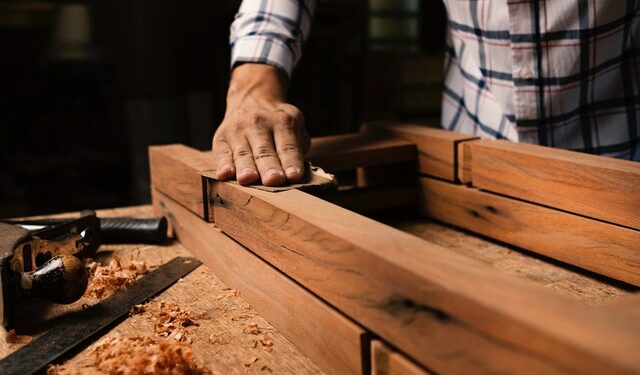How to distress stained wood with sandpaper

Distressing stained wood with sandpaper can be a great way to give it a more rustic look. Here’s how to do it:
1. Start by sanding the surface of the wood in the direction of the grain. Make sure to use very light pressure at first, and increase it gradually if needed.
2. Once you’ve sanded the entire surface, take a look at it and decide which areas need more distressing. Areas that have been exposed to more wear and tear will naturally be darker than the surrounding wood.
3. Sand those areas again until they are nice and distressed looking. Be careful not to overdo it, or you’ll end up ruining the finish altogether.
4. When you’re happy with the results, wipe away any dust and debris with a damp cloth. Allow the wood to dry completely before applying a finish, if desired.
That’s all there is to it! With a little bit of elbow grease, you can easily distress any stained wood surface.
1. What is distressing and why would you do it?
Distressing wood is a popular finish technique that gives furniture and other wooden objects a worn, antique look. There are several ways to distress wood, but the most common is to use sandpaper. In this tutorial, I’ll show you how to use sandpaper to distress stained wood.
2. What kind of sandpaper should you use?
The type of sandpaper you use will depend on the finish of the wood. If the wood is finished with a clear coat, you can use any type of sandpaper. If the wood is unfinished, however, you’ll want to use a finer grit sandpaper so you don’t damage the wood.
3. How do you distress stained wood with sandpaper?
There are two ways to distress stained wood with sandpaper: by hand or with a power sander. I prefer to do it by hand because it’s more control and I can avoid damaging the wood. But if you’re in a hurry, using a power sander will work just as well.
4. How do you know when the wood is distressed enough?
It’s up to you! You can stop whenever you like. I usually distress until about 50% of the stain is removed.
5. What do you do when you’re finished distressing?
When you’re finished distressing, simply apply a new coat of stain (if desired) and enjoy your beautiful, distressed finish!
The different ways to distress wood
Distressing wood can add a lot of character to a piece of furniture or home décor. There are several ways to achieve this look, but the most common is to use sandpaper. In this post, we will discuss the different ways to distress wood with sandpaper, as well as the best techniques for each.
The first way to distress wood with sandpaper is to create a light, even sanding over the entire surface. This will give the wood a general aged appearance and is perfect for pieces that you want to have a bit of character, but not necessarily look like they’ve been through a lot of wear and tear. To do this, simply sand the piece with a medium-grit sandpaper until the finish is dull and even.
If you want to create more of an antique look, then you will want to focus on distressing specific areas of the wood. This can be done by using a fine-grit sandpaper to lightly sand around edges, corners, and other areas that would naturally see more wear. You can also create deeper scratches and nicks by using a coarse-grit sandpaper or even a wire brush. Just be careful not to go too overboard, as you don’t want your piece to look too damaged.
Once you’ve achieved the desired amount of distressing, you can then finish the piece by staining or painting it. This will help to seal in the distressed look and protect the wood from further damage.
So there you have it – the different ways to distress wood with sandpaper. Give one of these techniques a try the next time you’re working on a project and see how it turns out!
How to distress wood with sandpaper
Distressing wood is a popular technique for giving furniture and other wooden objects a vintage or antique look. There are many ways to distress wood, but one of the simplest and most effective is to use sandpaper. In this tutorial, we will show you how to distress wood with sandpaper in just four easy steps.
1. Begin by sanding the wood with a medium-grit sandpaper. This will remove any existing finishes and prepare the surface for distressing.
2. Next, select the areas of the wood that you want to distress. You can do this by using a pencil to mark out the areas or by simply eyeballing it.
3. Once you have selected the areas you want to distress, begin sanding them with a heavy-grit sandpaper. Sand until you see the bare wood begin to show through.
4. Finally, finish up by lightly sanding the entire piece of wood with a fine-grit sandpaper. This will smooth out any rough edges and give the wood a uniform appearance.
And that’s all there is to it! By following these four simple steps, you can easily distress wood with sandpaper to create a unique and stylish look.
Tips for distressing wood like a pro
Distressing wood can add a lot of character to a piece of furniture, and it’s a technique that anyone can learn with a little bit of practice. Here are some tips for distressing wood like a pro.
1. Start with a piece of wood that has a smooth surface. You can distress any type of wood, but it’s best to start with something that’s easy to work with.
2. Choose the right sandpaper. For distressing wood, you’ll want to use a coarse sandpaper (like 60 grit) so that you don’t damage the surface.
3. Sand in the direction of the grain. This will help prevent any raised edges or splinters.
4. Work slowly and evenly. Don’t try to rush the process, or you may end up with an uneven finish.
5. Wipe away the dust after each sanding session. This will help you see your progress and know when to stop.
6. Finish with a fine sandpaper (like 120 grit) for a smooth finish.
7. Apply a finish of your choice. This will protect the wood and help preserve the distressed look.
Examples of distressed wood projects
Distressed wood has become very popular in recent years. There are several ways to achieve this look, but one of the simplest is to use sandpaper. In this post, we will show you how to distress stained wood with sandpaper.
If you are working with new wood, you will need to stain it first. We recommend using a dark stain, such as walnut or mahogany. Once the stain is dry, you can begin sanding.
Start with a coarse-grit sandpaper and sand the entire surface of the wood. Be sure to go with the grain of the wood so you don’t create any unsightly scratches. Once you have gone over the entire surface, switch to a finer-grit sandpaper and repeat the process.
Now comes the fun part! Take a piece of steel wool and rub it over the surface of the wood. This will create a distressed look that is perfect for many projects. If you want, you can also use a wire brush for this step.
Once you have achieved the look you want, you can finish the wood with a clear sealer. This will protect the wood and help to ensure that your distressed finish lasts for years to come. Thanks for reading! We hope this post has been helpful.
How to distress stained wood with sandpaper
Distressing stained wood with sandpaper is a great way to give your piece of furniture or décor a unique and aged look. In this article, we’ve outlined the steps you need to take to distress wood using sandpaper. Be sure to experiment with different grits of sandpaper and techniques to find what looks best on your project. Have fun and happy distressing!
What You’ll Need:
-Sandpaper (we recommend using at least 2 different grits, such as 60 and 100)
-Piece of wood to distress
-Staining agent (optional)
Instructions:
1. Begin by sanding your piece of wood with the coarser grit sandpaper. Focus on any areas that you want to look more distressed.
2. Once you’ve achieved the desired level of distressing, switch to the finer grit sandpaper and lightly go over the entire surface. This will help to smooth out any rough edges and give the wood a more uniform appearance.
3. If you want, you can now stain your wood to give it an additional layer of color. This step is completely optional, but can help to enhance the distressed look.
4. Once you’re happy with the way your wood looks, go ahead and seal it with a clear coat of polyurethane or another sealer of your choice. This will help to protect your distressed finish from wear and tear.
And that’s it! You’ve now successfully distressed stained wood using sandpaper. Be sure to experiment with different techniques and grits of sandpaper until you find the perfect look for your project.






